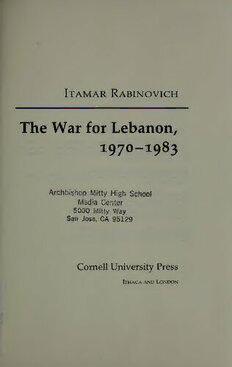
The War For Lebanon 1970-1983 PDF
Preview The War For Lebanon 1970-1983
Itamar Rabinovich The War Lebanon, for 1970-1983 Archbishop Mitty High School Media Center 5000 Mitty Way San Jose, CA 95129 Cornell University Press Ithaca and London The War for Lebanon, 1970-1983 Copyright © 1984byCornell UniversityPress Allrightsreserved. Exceptforbriefquotationsinareview, thisbook, orparts thereof, mustnotbereproducedinanyformwithoutpermissioninwritingfrom thepublisher. Forinformation, addressCornell UniversityPress, 124Roberts Place, Ithaca, NewYork 14850. Firstpublished 1984byCornellUniversityPress. Published in the United Kingdom by Cornell University Press Led., London. Second printing 1984. InternationalStandardBookNumber0-8014-1627-2 LibraryofCongressCatalogCardNumber83-45935 Printedin theUnited StatesofAmerica Librarians: LibraryofCongresscataloginginformation appearson thelastpageofthebook. Thepaperin thisbookisacid-freeandmeets theguidelines forpermanenceanddurabilityoftheCommitteeonProduction GuidelinesforBookLongevityoftheCouncilon LibraryResources. 12945 In memory of my father, Gutman Rabinovich, 1913-1983 Contents Preface 7 Chronology 13 1. The Lebanese Paradox 17 2. The Second Civil War, 1975-76 34 3. Political Parties and Factions 60 4. The Lingering Crisis 89 5. War, June-September 1982 121 6. An Interim Assessment 153 Postscript 174 Appendix: Speech by President Asad of Syria, July 20, 1976 183 Notes 219 Glossary 231 Index 237 MAPS 1. Smaller and Greater Lebanon 20 2. Lebanon's Major Communities 23 3. Lebanon's Areas of Control after 1975-76 War 46 4. Israel's Lebanese Campaign, June 1982 136 Preface The title of this book maybe somewhat misleading. The war for — Lebanon a conflict of domestic and external forces seeking to — shapeandcontroltheLebaneseentity beganlongbefore 1970and unfortunately did not end in 1983. But these years form a particu- larly significantphase in the history ofboth Lebanonandits imme- diate environment. The events of the period unfolded through four distinct stages: thecollapseoftheLebanesepoliticalsystembetween1970and1975, thecivilwarof1975-76, thelingeringcrisisoftheyears 1976-82and thewarof1982. AnewpostwarphasebeganinSeptember1982and is dealt with in chapter six and in the postscript. — Lebanon became Lebanon because of its relative insulation for centuries rugged Mount Lebanon attracted minority communities escaping governments bent on enforcing orthodoxy and unifor- mity. And yet the history ofmodern Lebanon reflectsa continuous interplaybetween domestic forces and external actors whose inter- vention has ranged from intellectual and economic influence to forceful occupation. The existence of the independent Lebanese republic during the thirty years following World War II was based on a delicate balance of domestic and external elements. In this respect the play of events between 1970 and 1983 represents a his- torical continuity. But there are three significant differences. One, the scope and intensity of external intervention were very much greater during these years. Two, the crisis in Lebanon had left the — Preface — periphery and become central to Middle East politics. Three and — most striking is that the three main external actors have them- selvesbeenprofoundlyaffected. ThePalestineLiberationOrganiza- tion found anadvantageousbase in Lebanon, butits establishment brought the organization to clash twice with Syria and made itvul- nerabletoaconcentratedIsraeliattack. Itsurvivedthefightingwith Syriain1976,butSyrianpressurein1982-83isprovingmorefateful. For the Syrian Ba'thi regime, its intervention in Lebanon triggered the domesticcrisis of 1977, which nearlybroughttheregime down. In 1983, it made a remarkable recovery from the military defeat of June 1982 and used its standing in Lebanon in order to build a position of regional and international influence. But its sense of achievement must have been tempered by a realization of the pre- cariousness of Syria's standing in Lebanon and of the possibility that all might change with another swing of the pendulum. In the early 1970s Israel was a marginal actor in the Lebanese crisis, which, in turn, did not rank high on its own agenda of pri- orities. Twelve years later, the evolution ofthe crisis and ofIsrael's domesticpoliticsandregionalpoliciesledIsraelintoaprincipalrole. The long-term significance ofthe 1982 warin Lebanon for the state of Israel has yet to be measured, but its short-term effect on the government that launched the warwas disastrous. The minister of Defense was forced to resign his post eight months later, and the prime minister resigned in September 1983 against a backdrop of continuingdeep IsraeliinvolvementinLebanonwithno satisfacto- ry end in sight. It is this interplay of the past few years between Lebanon's do- mesticpoliticsand developmentsin thelargerMiddleEastthatthis book primarily seeks to explore. Special emphasis has been laid on the 1982warand the events leadingto itfora number ofreasons their significance, their intrinsic interest, and the absence as yet of authoritativeworks, whichareavailablefortheearlierphasesofthe crisis. For the same reason the chapters that deal with the years 1977-82 seek to combine an interpretationwitha narrative account while those that deal with earlier periods and with the subject as a whole put a greater emphasis on interpretation. A book on a still unfolding crisis raises a number of obvious questions and difficulties. Is there a perspective from which these 10
